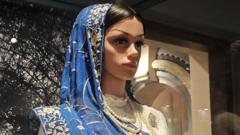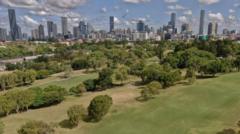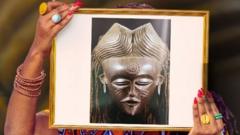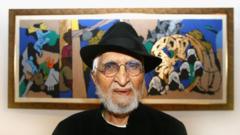The Framji Dadabhoy Alpaiwalla Museum, recently renovated, aims to preserve and present the legacy of India's Parsi community, highlighting its contributions through rare artifacts and exhibits that document Zoroastrianism's rich heritage.
Exploring the Legacy of the Parsis: A Glimpse into India's Ancient Zoroastrian Heritage

Exploring the Legacy of the Parsis: A Glimpse into India's Ancient Zoroastrian Heritage
The Framji Dadabhoy Alpaiwalla Museum in Mumbai reveals the rich history and dwindling presence of the Parsi community, showcasing invaluable artifacts from ancient Persia.
Nestled in a quiet street in Mumbai's southern district lies the Framji Dadabhoy Alpaiwalla Museum, a cultural gem dedicated to the Parsi community, followers of Zoroastrianism, one of the world's oldest religions. With only around 50,000 to 60,000 Parsis left in India, their unique heritage faces the threat of fading into obscurity. The museum serves as a beacon of knowledge, aiming to enlighten both locals and tourists about the community's vibrant history, culture, and traditions.
Curator Kerman Fatakia highlights the importance of the newly-renovated museum, stating that it inspires visitors to engage with the rare historical artifacts showcased. Among the displayed treasures are ancient cuneiform bricks, terracotta pots, coins, and other significant objects sourced from historical sites such as Babylon and Mesopotamia, dating back as early as 4000-5000 BCE. These items reflect the legacy of Zoroastrian kings from the Achaemenid, Parthian, and Sasanian empires.
A standout item in the museum is a replica of the Cyrus Cylinder, an ancient clay artifact associated with Cyrus the Great, which is considered one of the earliest charters advocating human rights. Maps tracing the migration of Zoroastrians from Iran to India during periods of persecution further underscore the community’s tumultuous past.
The museum houses exhibitions that portray the lives of prosperous Parsis, who thrived in the 19th century by trading luxury goods, including tea, silk, cotton, and opium. Displays also feature traditional Parsi sarees influenced by various global designs, emphasizing the community's historical connections through trade.
Among the most compelling aspects of the museum are the replicas of a Tower of Silence and a fire temple, showcasing the unique funerary practices and sacred rites of the Parsis. The Tower of Silence is used for exposing the deceased to nature, while the life-size replica of the fire temple provides an exclusive glance into a space normally off-limits to non-Parsis, designed with elements derived from ancient Persian architecture.
Originally established in 1952, the museum has undergone updates that enhance its exhibits with modern presentation techniques and informative guides. Fatakia emphasizes the museum's role as an educational resource, a vital space for those wishing to learn about the Parsi community and its historical significance in Mumbai and beyond. The Alpaiwalla Museum continues to stand as a testament to the perseverance and influence of the Parsi people, ensuring that their narrative does not vanish from the cultural landscape.





















